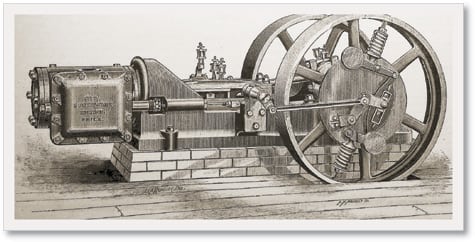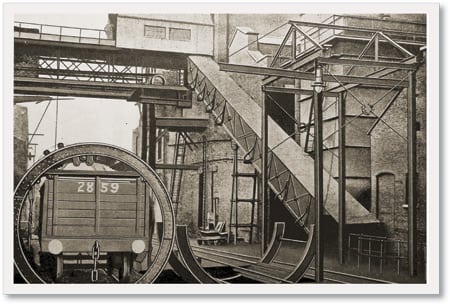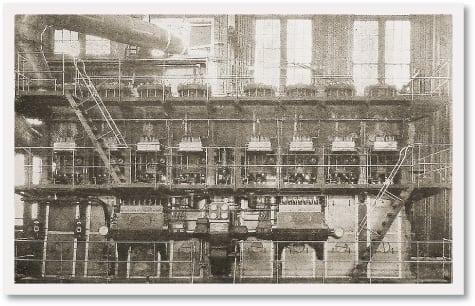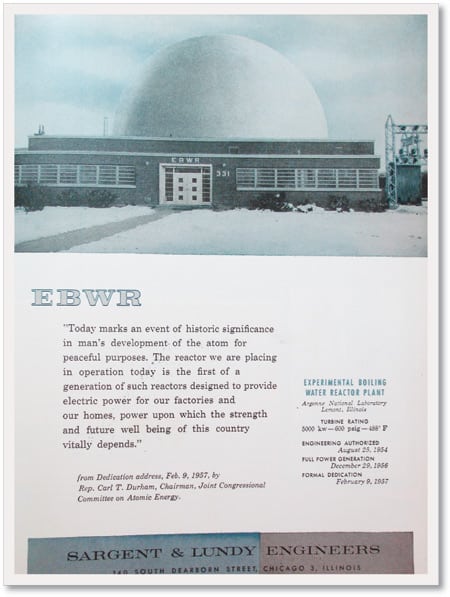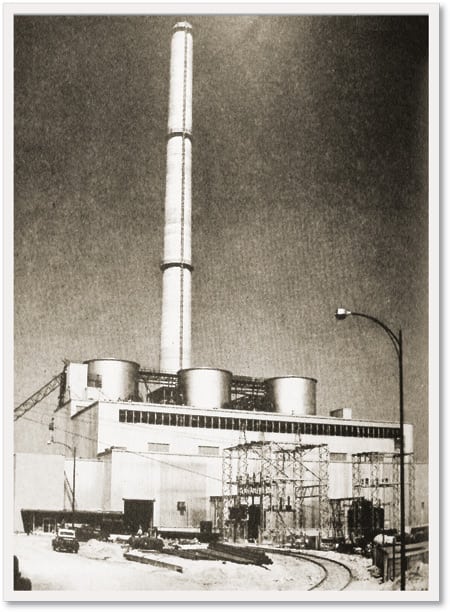This month in POWER…
April 1884
POWER reported on the latest offering from Philadelphia-based Southwark Foundry and Machine Co. (Figure 1) as its lead story. "This is a self-contained, high speed automatic cut-off engine. It has been designed with special reference to simplicity, and solidity of parts, and to heavy and continuous work.
|
1. The Southwark engine was the latest reciprocating engine offered for sale in the U.S.
|
"The main bearings are made with sideboxes, adjusted by wedges, and are well babbitted. The slide valve is a single light casting, and is balanced by a fixed coverplate, which relieves it of all pressure and provides a means of adjustment in case of wear.
"The governor is contained in a wheel, which serves the double purpose of fly wheel and belt drum, on one end of the engine shaft, and is in every way accessible. It is prompt in action and changes the point of cut-off from zero to five-eighth stroke, and operates the slide valve through a linkage without the use of an eccentric. Upon the other end of the engine shaft, which projects beyond the bed, a belt pulley may be placed. The pulleys, crank shaft and governor are all balanced, and the action of the governor is claimed to produce no disturbing forces, as there are two weights and two springs."
April 1907
The editors of POWER wrote a special report on coal handling that lamented the cause of spontaneous ignition. Coal-handling techniques may have improved in the past 100 years, but they haven’t completely solved many of the same problems we face today (Figure 2). "Coal-pile fires are not of infrequent occurrence, although it is very rarely that such fires are chronicled. Their cause is somewhat obscure, but they occur more frequently in bituminous coal, which contains considerable sulphur in the form of iron pyrites, though all coals of a friable nature are liable to spontaneous ignition.
|
2. Handling coal and preventing it from catching fire are two jobs that are as tough today as they were a century ago.
|
"There is considerable difference of opinion in regard to the causes of these fires. Moisture is by some considered to retard such ignition, but wet coal in compact masses has been known to catch fire spontaneously. Ventilation sufficient to evaporate the water and keep the heat of the pile down is probably the best method of overcoming such trouble, but restricted or insufficient ventilation is likely to increase the trouble.
"Spontaneous ignition is just as liable to occur in coal stored under cover as when open piles are used, but wet coal containing considerable pyrites will ignite if stored long enough to allow heating. Such fires are discoverable by the odor of the gases, difficulty in breathing at such portions of the pile, and by the heating of the coal. This last can be discovered by driving down pipes, through which thermometers can be lowered and the temperature taken, or in winter by the fact that snow will not remain on the pile, but melts away. It is impossible to fight such fires by water, unless the whole pile can be flooded and the entire air supply cut off in this way, for the reason that the fire cokes the coal adjacent to it previous to its burning, forming a roof which would shed most of the water, provided the water is not evaporated before it gets this far down in the pile, as is usually the case.
"In some cases pointed perforated iron pipes can be driven down in the pile, if it is not too deep, and water forced to the fire through them, but the most complete method is to remove the coal over the fire and then attack it.
"Another trouble with exposed coal piles and railroad shipments occurs in winter, when the coal often arrives frozen solid in the car, and the unloading tracks must be equipped with steam pipes and outlets for thawing purposes. The coal piles form a frozen crust which must often be broken up with dynamite in order to get out the daily requirements. From the foregoing it can be seen that the storage question is not a simple one, and must be handled with a full understanding of the many trials and tribulations that are likely to ensue."
April 1932
POWER described "one of five 7,000-b.h.p. double-acting two-cycle, solid-injection diesel engines of the M.A.N. type [Figure 3] being constructed by the Hooven, Owens, Rentschler Company, Hamilton, Ohio, for the municipal generating station of the City of Vernon, Calif. Each engine has eight cylinders of 24-in bore and 36-in. stroke, and will be direct-connected to a 5,000-kW, 6,900-volt, 50-cycle, 3-phase generator. Scavenging air will be supplied to the engines from separate, independently operated blowers. The engine-generator unit will measure 56-ft in length and weigh nearly 850,000 lb. Installation of the first unit will be started next month. When completed in January, the plant will be the largest diesel station in the world."
|
3. The five 5,000-kW two-stroke diesel engines installed in the City of Vernon, Calif., were the largest in the world at the time.
|
April 1957
The breaking news was Argonne’s boiling water reactor going commercial. "On December 21, 1956, the Experimental Boiling Water Reactor [Figure 4] first went critical. On December 28 it first produced 20-MW heat and the next day it generated 5-MW electric rated load, supplying power to Argonne National Laboratory, 
Lemont, Ill, located about 30 miles southwest of central 
Chicago."
|
4. The world’s first boiling water reactor went commercial in December 1956 at Argonne National Laboratory.
|
The success of this project demonstrated the commercial viability of the boiling water reactor design concept. The plant was shut down in 1967. Decommissioning of the EBWR began in 1986 and was completed in February 1996.
Also in this issue, POWER editors gushed over the success of a joint power plant–refinery development project (Figure 5). "Demonstrating faith in the adage that two heads are better than one, Delaware City Station and Tidewater’s Delaware Refinery have set up a beneficial share-the-wealth plan. The power station, part of Delaware Power & Light Co’s system, uses fluid coke as primary fuel. It is, in fact, the first large generating station in the U.S. designed to do so. With one first to its credit, DP&L got together with Tidewater and came up with a unique method of operations. Result: The power station supplies the refinery with power and process-steam; the refinery furnishes the power station with fuel, treated water and cooling water.
|
5. The construction of a Delaware Power & Light power plant and the building of a Tidewater Delaware refinery were handled as one project. The plant got fluid coke from the refinery in return for steam and power. Three 500,000-lb/hr boilers powered the first power station to be fueled by fluid coke.
|
"Farsighted thinking by Tidewater and DP&L led to planning and execution of this cooperative project. The oil company’s new refinery and the utility’s power station were built at the same time, about 15 miles south of Wilmington, Del. Engineering, design and field construction of both were handled as one project.
"Demand for 600-psig process steam varies from 300,000 to 800,000 lb per hr and the refinery’s power needs range from an 18,000-kW low to more than 40,000-kW peak. Such power and steam demand made a tie-in with DP&L an attractive solution."
